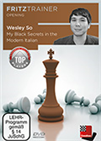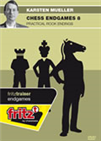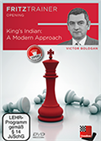“A tale of three matches”
That is how commentator Maurice Ashley described the confrontation between Magnus Carlsen and Jeffery Xiong. The world champion kicked off with three straight wins, lost two out of the following five encounters and, after Xiong blundered and lost game 9, went on to cruise to victory adding two more wins to his tally.
19-year-old Xiong is the fifth highest rated player in the United States and was invited to the tournament most likely due to Hikaru Nakamura (the country's number four) not being available to participate. The youngster was grateful for having had a chance to play against the world champion, while Carlsen confessed things could have easily gone differently:
Today could have gone either way. [...] It was definitely not easy at all, and it was a bit frustrating to go so many games without winning or playing particularly well.
Former US champion Sam Shankland — incidentally, the country's number six in the FIDE ratings list — praised his young compatriot's play on Twitter:

The other quarterfinal match that finished on Monday saw Wesley So eliminating second seed Maxime Vachier-Lagrave — official FIDE rapid ratings are in place. So entered day two with a three-point advantage on the scoreboard. After two draws, ‘MVL’ shortened the gap with a win in game 9. The last encounter before the clutch-game section was also drawn, which meant the American had a two-point lead with 6 points still up for grabs (games 11 and 12 grant 3 points for a win).
Thus, a win and a draw would have been enough for Vachier-Lagrave to reach the semifinals. It was not meant to be for the Frenchman, though, as So won the match with a round to spare by adding 3 points to his tally in the first clutch game. The American also won the last encounter, when Vachier-Lagrave's attempts to complicate matters at all costs badly backfired.
 The Italian Game is considered a sound but quiet opening without early trades, giving rise to rich positions where plans are more important than forced variations. So shows black's plans on this DVD.
The Italian Game is considered a sound but quiet opening without early trades, giving rise to rich positions where plans are more important than forced variations. So shows black's plans on this DVD.
Carlsen will face the winner of Alexander Grischuk v Levon Aronian, while So will be paired up against the winner of Fabiano Caruana v Leinier Dominguez. The second half of these matches will be played on Tuesday.
Carlsen 11½:6½ Xiong
Day two of the matchup started with Xiong levelling the score thanks to a convincing victory with the white pieces. Then, the youngster held the world champion to a draw with black in a game that lasted no fewer than 104 moves — Carlsen kept trying to provoke a mistake by his opponent in a pure rook v knight ending.
Game 9 was the turning point, as pointed out by Xiong. The 19-year-old had a favourable position in the middlegame, but spent too much time trying to figure out how to make the most of it. Then, in an equal rook endgame, he blundered decisively on move 42:
 Rook endings are amongst the most frequently encountered endgames there are, and so your training effort will be quickly repaid in the form of half and full points. Knowing even a few rules of thumb and key methods makes life a great deal easier and provides a guiding light even in complex positions. This DVD focuses on the important themes which are to be found in common rook endings.
Rook endings are amongst the most frequently encountered endgames there are, and so your training effort will be quickly repaid in the form of half and full points. Knowing even a few rules of thumb and key methods makes life a great deal easier and provides a guiding light even in complex positions. This DVD focuses on the important themes which are to be found in common rook endings.
42.Kd4 allowed 42...Rf4+ and White is already in trouble. Continuing with 43.Kd3 would have kept the game going, although it is very likely that Carlsen would have converted from that position. However, the game continuation 43.Re4 Rxe4+ 44.Kxe4 Kf6 is curtains — Black will get a passer on the kingside with decisive effect.
All momentum was lost for the youngster at that point, and he ended up losing his two remaining games with black. It was a real scare for the world champion nonetheless!
| |
Total |
G1 |
G2 |
G3 |
G4 |
G5* |
G6* |
G7 |
G8 |
G9 |
G10 |
G11** |
G12** |
| Magnus Carlsen |
11½ |
1 |
1 |
1 |
½ |
0 |
½ |
0 |
½ |
1 |
1 |
½ |
1 |
| Jeffery Xiong |
6½ |
0 |
0 |
0 |
½ |
1 |
½ |
1 |
½ |
0 |
0 |
½ |
0 |
*Games 5 and 6 are worth two points each
** Games 11 and 12 are worth three points each
Select an entry from the list to switch between games
So 13:5 Vachier-Lagrave
While So was clearly the one calling the shots in the first half of this match, day two saw more of a balanced fight, at least in the first four games. Two hard-fought draws were followed by what would end up being Vachier-Lagrave's sole win of the match. The Frenchman played a sharp King's Indian Defence in the next game:
 Bologan: "If you study this DVD carefully and solve the interactive exercises you will also enrich your chess vocabulary, your King's Indian vocabulary, build up confidence in the King's Indian and your chess and win more games."
Bologan: "If you study this DVD carefully and solve the interactive exercises you will also enrich your chess vocabulary, your King's Indian vocabulary, build up confidence in the King's Indian and your chess and win more games."The computer thinks 28...Bxc3 is winning for black, and it is very likely that Vachier-Lagrave would have deeply considered the capture in a classical game. With this format, however, France's number one opted for 28...Rxe4 and saw his opponent getting plenty of counterplay after 29.Rc8+. Vachier-Lagrave doubled his rooks on the second rank and was eventually forced to give perpetual check in order to avoid defeat.
The match was decided in the next encounter, as So gained two pawns in the middlegame by outcalculating his opponent in a complex position. Vachier-Lagrave's woes continued in the last game of the match, as he lost in merely 15 moves while trying to muddy the waters with the black pieces.
| |
Total |
G1 |
G2 |
G3 |
G4 |
G5* |
G6* |
G7 |
G8 |
G9 |
G10 |
G11** |
G12** |
| Wesley So |
13 |
½ |
½ |
½ |
1 |
1 |
½ |
½ |
½ |
0 |
½ |
1 |
1 |
| Maxime Vachier-Lagrave |
5 |
½ |
½ |
½ |
0 |
0 |
½ |
½ |
½ |
1 |
½ |
0 |
0 |
*Games 5 and 6 are worth two points each
** Games 11 and 12 are worth three points each
Select an entry from the list to switch between games
Links

























